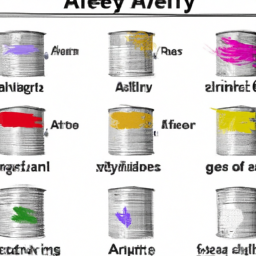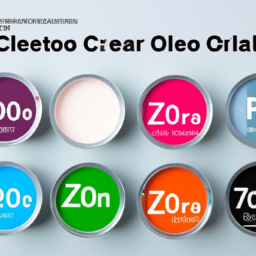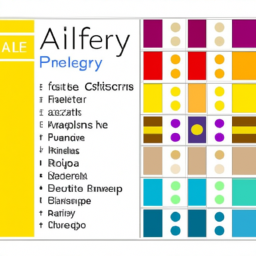Hey there! Looking for the perfect allergy-friendly paint? Well, you’re in luck! In this article, I’ll be sharing a quiz that will help you find the ideal paint for your needs.
We’ll explore the benefits of non-toxic paint, identify common allergens in conventional paint, and highlight key features of allergy-friendly options.
I’ll also provide tips on how to choose the right paint and introduce you to some top brands in this space.
So let’s get started and find the perfect allergy-friendly paint for you!
Benefits of Non-Toxic Paint

I love the numerous benefits of using non-toxic paint. When it comes to painting my home, safety precautions and health concerns are always at the forefront of my mind. Non-toxic paint provides me with the peace of mind I need, knowing that I’m creating a safe environment for myself and my family.
One of the biggest advantages of non-toxic paint is its low volatile organic compound (VOC) content. VOCs are chemicals that evaporate into the air, and they can have detrimental effects on our health. Non-toxic paint contains minimal or no VOCs, making it a much safer option. This means that I don’t have to worry about inhaling harmful fumes or experiencing any respiratory issues.
Furthermore, non-toxic paint is also environmentally friendly. By using paint that’s free from harmful chemicals, I’m reducing my carbon footprint and contributing to a healthier planet. It’s a win-win situation!
Another benefit of non-toxic paint is its ease of use. It applies smoothly and dries quickly, making the painting process efficient and hassle-free. I don’t have to sacrifice convenience for safety.
Common Allergens in Conventional Paint

When considering the benefits of non-toxic paint, it’s important to acknowledge the presence of common allergens in conventional paint. These allergens can pose health risks and cause discomfort to individuals with sensitivities or allergies.
Here are four common allergens found in conventional paint:
Volatile Organic Compounds (VOCs): VOCs are chemicals that can evaporate into the air at room temperature. They’re commonly found in conventional paint and can cause respiratory irritation, headaches, and dizziness.
Formaldehyde: This chemical is often used as a preservative in paint. Exposure to formaldehyde can lead to allergic reactions, respiratory issues, and even cancer in extreme cases.
Heavy Metals: Some conventional paints contain heavy metals like lead, mercury, and chromium. These metals can be toxic and pose serious health risks, especially to children and pregnant women.
Fragrances: Many conventional paints contain synthetic fragrances that can trigger allergic reactions in sensitive individuals. These fragrances can cause respiratory issues, skin irritation, and headaches.
Understanding the common allergens in conventional paint is crucial for maintaining a healthy living environment. By opting for non-toxic paint options, you can minimize the risks associated with these allergens and create a safer space for yourself and your loved ones.
Key Features of Allergy-Friendly Paint

To ensure an allergy-friendly environment, it’s important to consider the key features of paint that can minimize allergen exposure. When choosing paint options, it’s crucial to opt for allergy-friendly paint that’s specifically designed to reduce allergens and promote a healthier living space. These allergy friendly paint options have several key features that make them ideal for individuals with allergies or sensitivities.
One of the main features of allergy-friendly paint is that it’s non-toxic. Traditional paints often contain harmful chemicals, such as volatile organic compounds (VOCs), that can trigger allergies and respiratory issues. Non-toxic paint, on the other hand, is formulated without these harmful substances, making it a safer option for those with allergies.
Another important feature of allergy-friendly paint is its ability to resist mold and mildew growth. Mold and mildew can be major allergens, causing respiratory problems and other health issues. Allergy-friendly paint is specially formulated to prevent the growth of mold and mildew, reducing the risk of allergen exposure.
Additionally, allergy-friendly paint is often low in odor. Strong paint fumes can be irritating to individuals with allergies or sensitivities. By choosing paint with low or no odor, you can minimize the risk of triggering allergic reactions or respiratory problems.
How to Choose the Right Allergy-Friendly Paint

As someone with allergies, I’ve found that the key to choosing the right allergy-friendly paint is considering its specific features and benefits. When it comes to selecting the perfect paint for allergy sufferers like myself, there are a few important factors to keep in mind:
Choose eco-friendly options: Opting for paints that are labeled as eco-friendly or low VOC (volatile organic compounds) is crucial. These paints are formulated with fewer harmful chemicals, reducing the risk of triggering allergies or respiratory issues.
Understand paint ingredients: It’s essential to familiarize yourself with the ingredients used in the paint. Look for paints that are free from common allergens like formaldehyde, ammonia, and benzene. Additionally, ensure that the paint doesn’t contain any synthetic fragrances or dyes, as these can also be irritants.
Consider hypoallergenic options: Some paint brands offer hypoallergenic options specifically designed for individuals with sensitivities. These paints are formulated to minimize the chances of allergic reactions and are often tested for allergens.
Seek recommendations: Don’t hesitate to seek recommendations from professionals or fellow allergy sufferers. They may have firsthand experience with allergy-friendly paints and can provide valuable insights and suggestions.
Top Allergy-Friendly Paint Brands

Continuing the discussion on allergy-friendly paint, let’s explore some of the top brands available in the market. When it comes to choosing an allergy-friendly paint, it’s important to consider the brand’s reputation for producing non-toxic and low VOC (volatile organic compounds) products.
Some of the top allergy-friendly paint brands include Benjamin Moore, Sherwin-Williams, and Behr.
Benjamin Moore is known for its wide range of low VOC and zero VOC paint options. Their products aren’t only allergy-friendly but also provide excellent coverage and durability.
Sherwin-Williams offers a variety of paint lines that are free from harmful chemicals and allergens. Their Harmony line, in particular, is designed to reduce airborne allergens and is certified asthma and allergy-friendly.
Behr is another brand that prioritizes the health and safety of its customers. They offer a range of low VOC paints that are odorless and environmentally friendly.
Using non-toxic paint has several benefits. It can improve indoor air quality by reducing the presence of harmful chemicals and allergens. Non-toxic paint is also safer for children and pets who may be more sensitive to environmental toxins. Additionally, it’s better for the environment as it minimizes the release of pollutants into the air and waterways.
Frequently Asked Questions
Can Non-Toxic Paint Help Reduce Indoor Air Pollution and Improve Overall Indoor Air Quality?
Yes, non-toxic paint can help reduce indoor air pollution and improve overall indoor air quality. Its benefits include minimizing harmful chemicals and reducing the impact of indoor air pollution on our health.
Are There Any Harmful Chemicals or Volatile Organic Compounds (Vocs) in Allergy-Friendly Paint?
Yes, there may be harmful chemicals or volatile organic compounds (VOCs) in allergy-friendly paint. It’s important to check labels for low VOC or zero VOC options to preserve indoor air quality.
Can Allergy-Friendly Paint Be Used in All Areas of the House, Including High-Moisture Areas Like Bathrooms and Kitchens?
Yes, allergy-friendly paint can be used in all areas of the house, including high-moisture areas like bathrooms and kitchens. It is designed to be durable and resistant to moisture, making it a suitable choice for these environments.
How Long Does Allergy-Friendly Paint Typically Last Before Needing to Be Repainted?
Allergy-friendly paint typically lasts for several years before needing to be repainted. It offers the benefit of reducing allergens in the home, making it a great choice for those with allergies or sensitivities.
Is Allergy-Friendly Paint More Expensive Than Conventional Paint, and Is It Worth the Investment?
Allergy-friendly paint is usually more expensive than conventional paint, but it’s definitely worth the investment. The cost comparison is important, but the benefits of allergy-friendly paint, like improved air quality, make it worthwhile.
Conclusion
In conclusion, choosing allergy-friendly paint is essential for those with sensitivities or allergies.
Non-toxic paint offers numerous benefits and can help reduce exposure to common allergens found in conventional paint.
When selecting the right allergy-friendly paint, it’s important to consider key features such as low VOC levels and certifications from reputable organizations.
Top allergy-friendly paint brands are available in the market, providing safe and eco-friendly options for a healthier living environment.